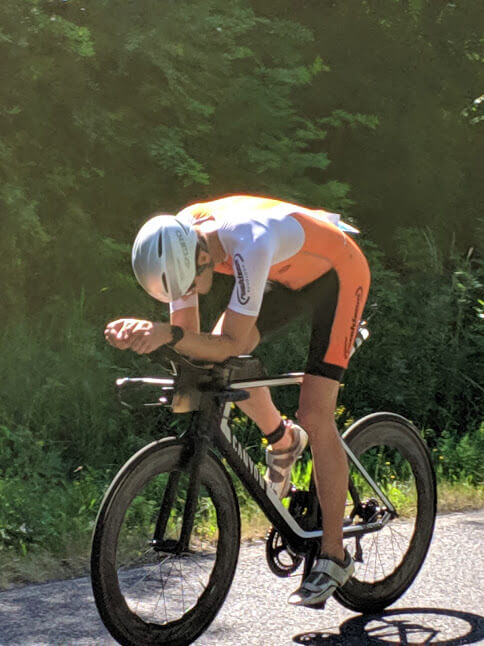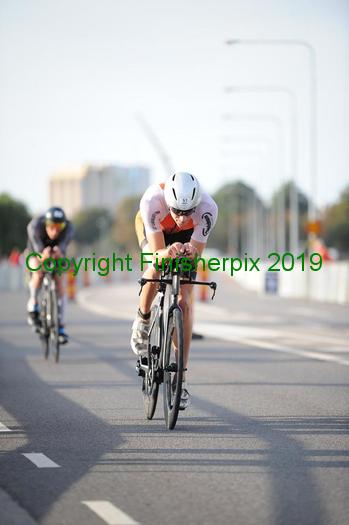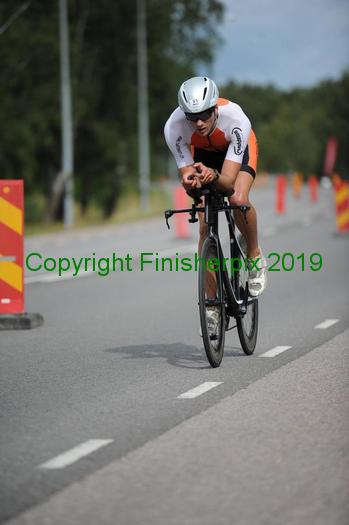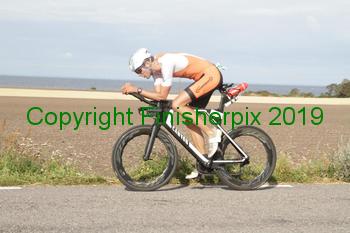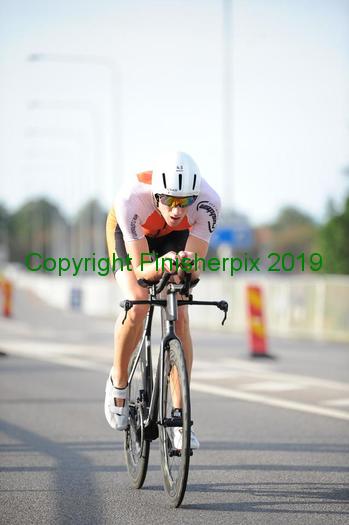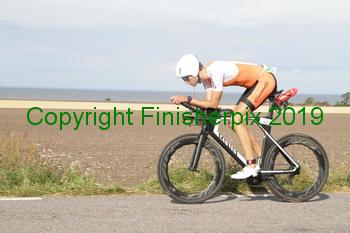What it takes to be an ironman pro?
— A look at our bike weakness
Frankfurt and Kalmar DNFs
Jean-Claude already went into the details of our disappointment at IM Frankfurt which was supposed to be our main objective this year. It was a hell of a furnace and I totally agree with him: being a pro is also being able to try and say, “Today was not my day; I will try another one later”. And while we are not full-time pro triathletes, and deciding to race Kalmar meant more investment than for others (like taking vacations from our 100% job), I am still convinced we took the right decision of not finishing in 9 hours or more on the last day of June.

Early morning race-day wake-up in Kalmar.
So, then came logically the question of why Kalmar. The famous spectators? The great swim and run course for supporters? The fast course? No, we wanted one in Europa (less travel), not too hot, and not too late because the form was there already with Frankfurt’s preparation. Left on the list were Kalmar and Barcelona, with an advantage for Kalmar due to being earlier. And so we did our short transition from Germany to Sweden. Well, saying it went without troubles would be lying; Jean-Claude had to go to France for work for one month with complex training possibilities while I did not run at all and spent a few evenings at the physiotherapy for an inflamed Achilles tendon. Alright, Kalmar may be fast, but may also not be anything for me. Health is still the priority over an ironman and it is not THE race of my life that I have to finish at all costs. So yes, DNF is again an option. However, it also means I have more possibilities to try myself out and make a good training out of it. Jean-Claude will detail the race I guess, for me this was just an introduction to my point of today: How pro are we actually?
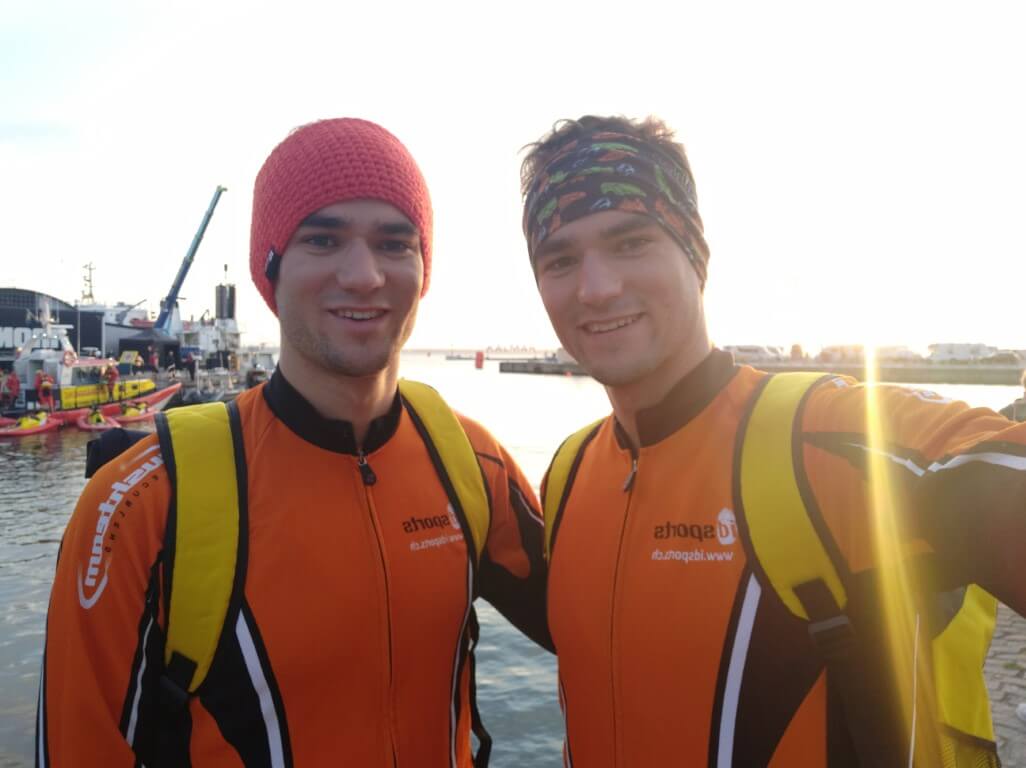
Pre-start selfie in a refreshing atmosphere.
Barely pro by the numbers
If we follow the guideline of the Swiss triathlon federation, anyone in the 10% of the top-level worldwide athletes can ask for a professional license. So yeah, good for us, they only go by competition results, because with a 100% job (PhD in physics at ETH for J-C and microelectronics engineering at ACP for me) and no links to a national team or any structure from the federation, we would be pretty chanceless otherwise. Let’s see: an ironman winner in the 7h45 leaves us an 8h31:30 finish. Tight, very tight but not unachievable. Breaking it down:
- Swim: 45’-48’ x 1.1 = 49’30-53’ (1’18-1’23 /100m)
- Bike: 4h05’-4h10’ x 1.1 = 4h29’30-4h35’ (39.3-40 km/h)
- Run 2h45’-2h50’ x 1.1 = 3h01’30-3h07’ (4’18-4’25 /km)
Compared to my typical time, the swim "cut-off" is quite easy to achieve (48’-50’ with wetsuit, 50-52’ without). The run one is doable if not too tired from the bike (at least on a good day, already did sub-3h in Barcelona, and 3h10’ or less has always been the goal even if not always achieved). But the bike is a whole different story, I started my ironman races considering a 4h50’ as too optimistic, more or less planning for a sub-9h with the 30’ on 8h30’ lost almost entirely on the bike. 40kmh on the bike was what I was looking for on an Olympic event and to hold the same on 4.5 times the distance and then run a marathon was an idea very far from me.

Frontal bike video one week before Kalmar.
Since then however, I have got Powertap P1 pedals with power, a Velocomp aeropod to analyze my position on the full event length, and an opportunity in Kalmar to compromise a bit my marathon if it has to happen, because anyway I will have to decide in T2 if I put the shoes on or not. And there it was, just like that, dreaming of 4h30 and making my thoughts on whether it will one day become a thing for me and not only for those extraterrestrial überbikers.
I did it
If there should be a single reason why I am happy I did travel to Sweden this week-end is that now I can confidently say that it is doable. After a freaking fast swim in 45’ and leading the first pack in the water, I did a 39.4km/h bike in 4h32’ on a flat and windy course. Sure, the conditions were there to perform great and it might not be the same on any course I will take part, but I did pace my race alone and was well into 40km/h average up to 140km and still very close to it when we include the last part with front wind and a lot of turns on smaller roads. Also, this time no one (me included) can put my performance on the group effect or on drafting. I was basically leading the first pack during more than half of the swim (with one athlete more than a minute ahead, the one who made the times so fast by forcing everyone to take a scandalous head-start on the start line by taking advantage of the fact that there was no line, no kayak, or no one saying anything when he started swimming before the gun). Then the bike resumed to me being passed by a lot of people too fast for me up to kilometer 30-40, sometimes trying to keep up with them but giving up when I saw my power numbers going up to 320W. Riding with another guy and a referee from 37 to 50 and then dropping him and finishing my ride all alone. Yeah, no drafting, barely any pacing from someone and a well-regulated pro race if everyone experienced the same (a big if).
What did I do?
Position
Most of my thinking goes then to what changed or what I did differently such that it was made possible. I think personally that we have to go back a little and explain part of this in comparison to previous years and not directly trying to isolate this race. One thing we changed with Jean-Claude is position on the TT bike; once or twice in bigger steps (such as when we changed bike), a lot more times in ever-so-slight steps that the difference is almost imperceptible and the impact more-so unsure with all the sayings and contraries one can read on aerodynamics. The end result is nevertheless undeniably present and no one can deny that our position noticeably improved on the long term. My elbows got a lot narrower and lower than at the beginning and allowed me to have a tucked position with the head completely or almost completely hidden in the aero-shade of the back. I often have to think about it to hold the position but when I do it is quite nice.
Confidence
I was almost going to merge this point with the precedent about position, but somehow this is sometimes the (hardly-learned) difference between a nice position on a roller or in wind-tunnel and an aero position on an ironman. Öland, the island in front of Kalmar where the first 120k loop takes place, was windy Saturday; at least for our Swiss standards with Jean-Claude. A few years ago, I would have probably left the aerobars for the safer feeling in the drop-out position relatively often. This time, I just pushed more watts in the two main crosswind sections of around km 50 and 90, partly because I feel more in control when I can push on the pedals and partly because I knew tailwind sections would follow and allow me to relax a little. The point of a good position is to ride it. In Klamar, the only time I didn’t felt like riding it safely was for the very short descent of the bridge on the way back around km 115. Ideally, I would have had a bigger gear for this portion to be able to push and mentally feel safer; once in 180km is not a big deal though. À propos material, Kalmar is the typical course where I would have had a bigger chain ring and dropped the small one and the front derailleur if I had to optimize everything…
Power
It seems up to now that I am putting everything on position and course, but in the end I still pushed some watts and it does come down to this. 273W normalized and 268W average to name it, not nothing in my opinion. And for once (maybe because of my mentality of not worrying about the marathon too much), I did not fear to push more on some portions and modulate them depending on tail-, cross-, or headwinds. If you ask me now, I have the impression that I almost went out too fast at the beginning and allowed myself too many portions over my wattage and speed goals. Some effort modulation is good when there is wind, climbs, or other course particularities, but it can cost you something in the end if exaggerated.
Room for improvement
Power, power, power. It is improving for us but surely not to the professional level. Boris Stein (who took the win and passed me on the bike) has reportedly said before the race that he planned to push around 350W to catch up on the faster swimmers and then go on with 320W. If the time difference is huge on the bike, the difference in power numbers is as well. This means just one thing, training; more and better.
There is another pattern however that came up both in Frankfurt and Kalmar: I get tired after 4 hours of riding. With me being more used to do long rides with the TT in training, the fatigue towards the end of the bike portion doesn’t show up all too much in the time, but it is a very clear felling for me that translates into me getting bored of the aggressive aero position and have more and more the tendency to get out of the aerobars on every small climb or curve to stretch and change the stress on the legs muscles. I am not yet 100% sure what it is exactly, I suspect simply muscle fatigue and boredom of the regular effort without changes in the position; some may come from energy levels and nutrition as well though. If I don’t have a straight solution for this, the end effect is very clear in that I spend too much effort in the end of the ride to keep up the pace at a critical time just before the marathon. Until now, this turned out better than it seems as the massive change in muscles being used from biking to running made for a better-than-expected feeling at the beginning of the marathon. I would still consider this a problem that would be nice to fix. This pattern was up to now purely based on feeling, but it is also clearly recognizable on the wasted watts plot by the aeropod.
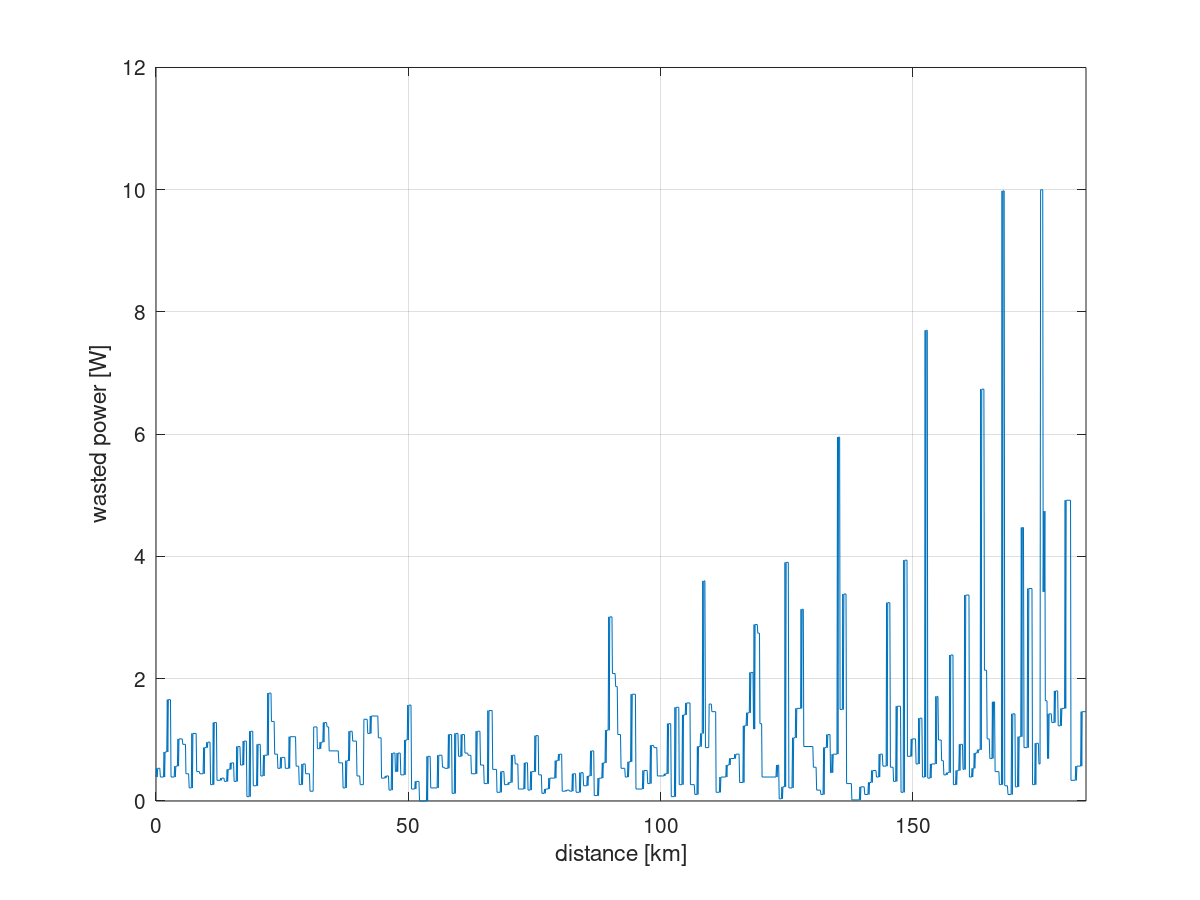
Wasted watts export from Velocomp's Isaac software for the bike in Frankfurt. I get more and more tired and out of aerobars with the duration of the ride.
What now?
One of the reasons of this post is to vent about not being able to race Kalmar and answer all the people who congratulated me and told me not to be upset about not finishing. While I find it very nice and thoughtful, I must say I did not find it too hard on myself to give up in T2. I took the decision fully conscious that it would probably mean that I am not going to finish an ironman this year, but prioritizing the recovery of my Achilles tendon made much more sense at the moment, just like not forcing an overheat on my poor body made perfect sense in Frankfurt. I love racing ironman (I wouldn’t for the money as I am a pro spending to race), but ironman is not everything and none of those two was a race I had to finish so bad that I would put the result over my health. So first and foremost, get healthy and running pain free again.
Nevertheless, running 1.6km with Jean-Claude after a 10 minutes break in T2 felt nice and I even felt like I could talk although the pace he set at the start of his marathon was way too fast in my opinion (targeting 2h50’ or below). Therefore I believe that this tiredness at the end of the bike is still somewhat linked to the bike position and, if I can solve it, running a 3 hours marathon after biking a 4h35’ or the like is possible. It is easy to say it like that without having done it, but this is my key outcome from Kalmar and I am very happy to have done the travel there to have confirmed this. Very happy, I am of course for Jean-Claude as well, who seriously put into danger my record time from Barcelona and got oh-so close to 8h30’, which he always told me was a long term goal but probably not achievable that soon for him. Every couple of minutes now is a matter of details, and we still have a lot of those to tune in perfectly. Somehow it also means taking more risks as we are clearly racing to the fastest time our condition allows rather than racing to finish. If that’s what it takes to race pro, I will continue like that (well, without injuries…) because I like feeling like a pro and shooting for the best.
Links to activities
And because there is nothing better than checking by yourself instead of trusting someone relating his impressions, here my data for both races in Frankfurt and Kalmar. Any comments or analysis welcome!
- Frankfurt:
- Kalmar:




